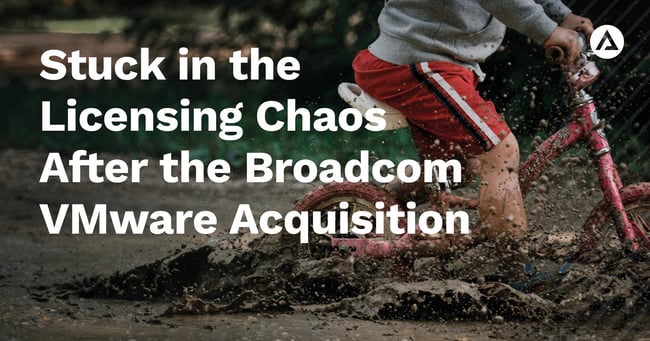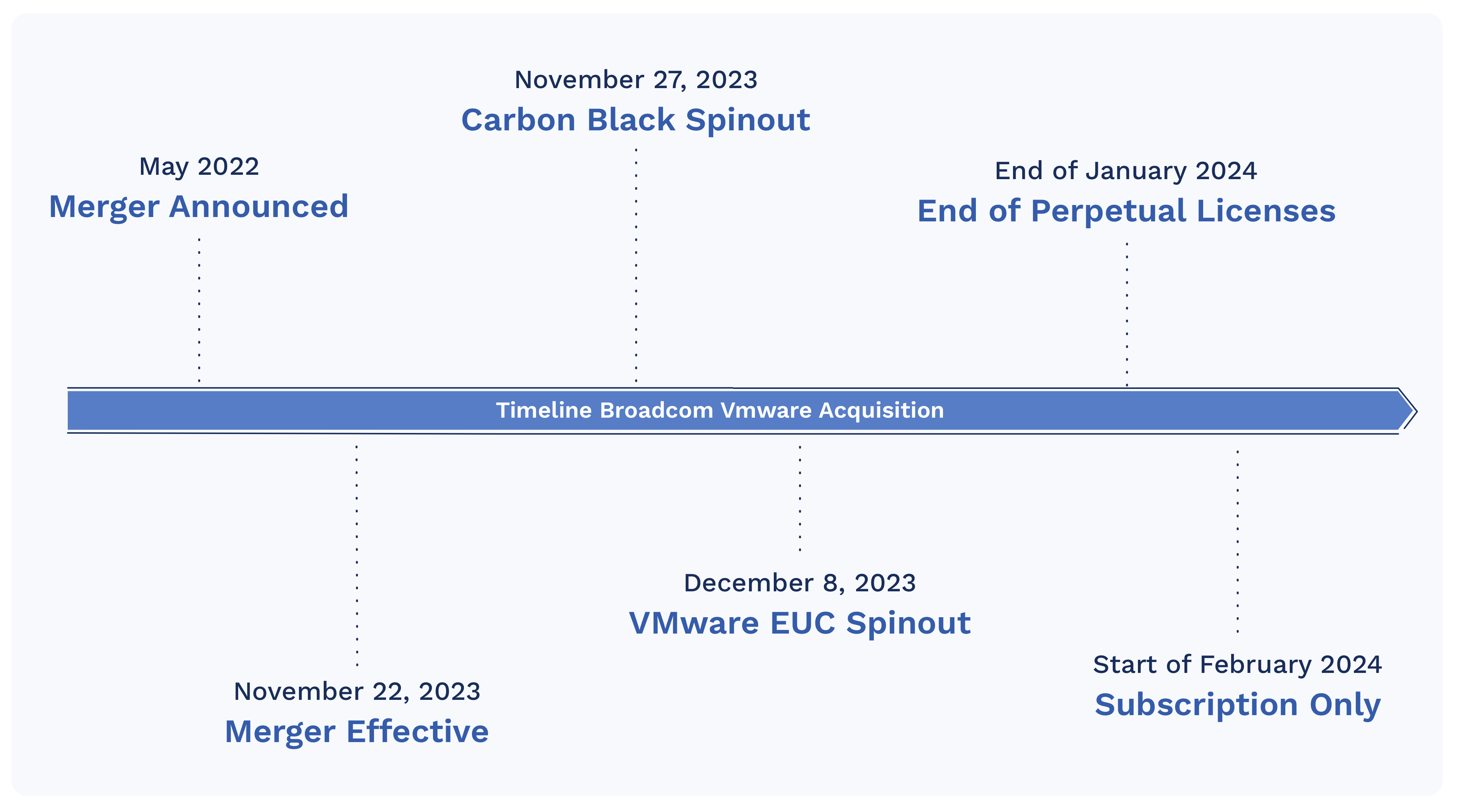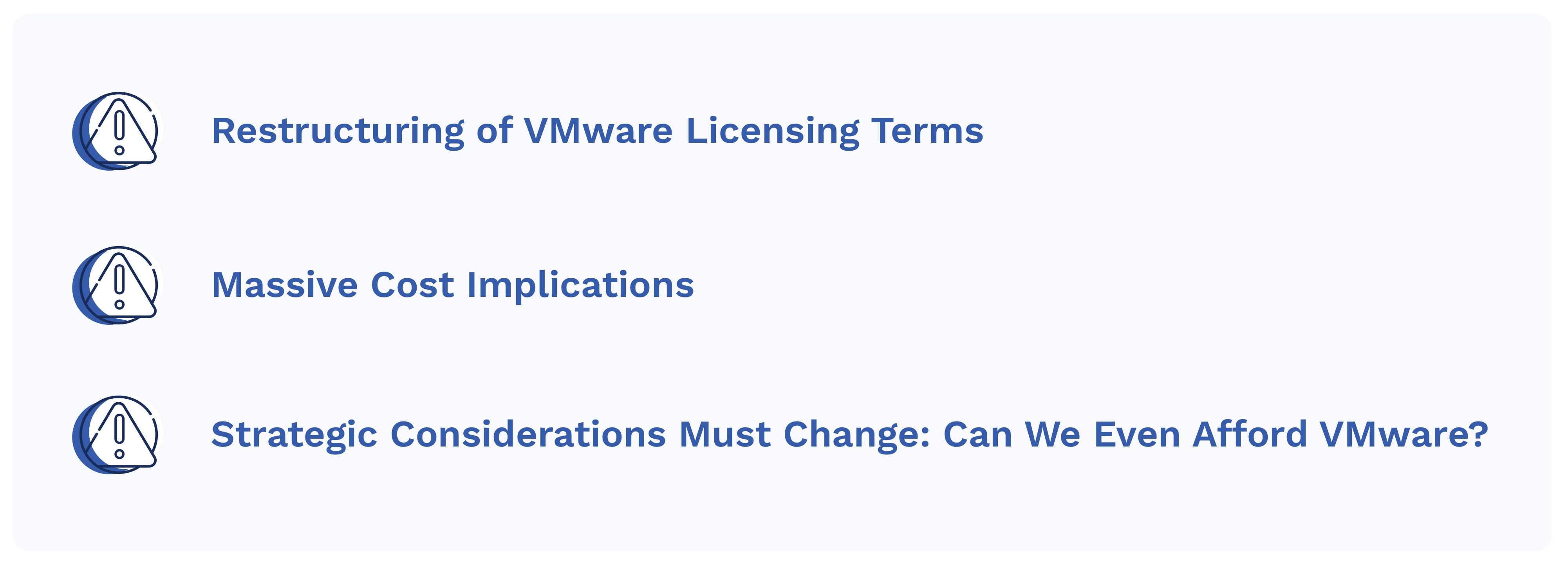The acquisition of VMware by Broadcom has emerged as a landmark event, capturing the industry's attention and sparking widespread speculation regarding its implications.
Announced in May 2022, this takeover represents a significant pivot for Broadcom into the private and hybrid cloud computing market. This strategic move has prompted current VMware customers to closely examine the consequences for their private and hybrid clouds, cloud infrastructure management, and virtualization services.

The most impactful change of the Broadcom VMware merger is the change in license policy and the dramatic product portfolio simplification.
The transition from perpetual licenses to a subscription-based model and the change from a CPU-based to a per CPU Core-based model marks a critical turning point for existing VMware users. It signifies not just a shift in licensing structures but also broader changes in how enterprises will access and pay for virtualization and cloud services moving forward.
In this detailed guide, we navigate through the timeline of the Broadcom VMware takeover and dive into the strategic considerations for customers impacted by the license changes.
The goal is to help you make informed decisions for the continued use of VMware products in your virtualization and hybrid cloud architectures. Should you stay with VMware under Broadcom's management or move to alternative platforms?
Timeline of the Acquisition

- Merger Announced: May 2022
Broadcom announced its intention to acquire VMware in a monumental deal, signaling a strategic expansion into the cloud computing market.
- Merger Effective Date: November 22, 2023
The acquisition was completed on November 22, 2023, following regulatory approvals. This date marks the official beginning of VMware's integration into Broadcom's operations.
- Carbon Black Spinout: November 27, 2023
VMware announced that Carbon Black will be an autonomous business unit within Broadcom, preparing a spinout.
- VMware EUC Spinout: December 8, 2023
Broadcom CEO Hock Tan confirmed on their earnings call that it will be divesting itself of VMware’s End User Computing (EUC) business units, including its Desktop as a Service (DaaS) offerings.
- End of Perpetual Licenses: End of January 2024
Shortly after the acquisition's finalization, Broadcom announced changes to VMware's licensing model. This included the perpetual license phase-out, dramatically simplifying the portfolio, and changing the per CPU-based licensing to a per CPU Core-Based licensing.
- Subscription Only: Start of February 2024
Broadcom stopped transacting its perpetual VMware license and transitioned to subscription licenses. This move aims to align Broadcom's offerings to a subscription model for software and cloud services for the private and hybrid cloud market.
The Severe Impact on Licensing on VMware Solutions
One of the most significant changes that followed Broadcom's acquisition of VMware was the dramatic simplification of the product portfolio reducing the available product SKUs.
This drastic consolidation has profound implications for existing VMware customers, affecting everything from licensing flexibility to cost structures and product availability.
Understanding the Simplification of VMware's Product Portfolio
In the context of VMware products, SKUs represent the different configurations and licensing options available for VMware's diverse virtualization and cloud services suite.
Before the acquisition, VMware offered a broad array of SKUs, allowing customers to tailor their licensing agreements closely to their specific needs and usage scenarios. The decision by Broadcom to streamline VMware's SKU offerings to approximately 100 reflects a strategic shift towards simplification and standardization in license bundles.
However, this transition also comes with dramatic implications that could have an enormous impact on budget and architecture.
From per CPU Socket to per CPU-Core Licensing
Under the previous CPU-based licensing model, VMware customers would acquire licenses based on the number of CPUs in their servers, regardless of the number of cores in each CPU.
The new model transitions to a core-based licensing system, requiring licenses for each core within a CPU. The critical condition here is the establishment of a minimum core count threshold of 16 cores per CPU.
For example, should your server's CPU possess less than 16 cores, the licensing requirement states that you'll still need to buy 16 cores per CPU, which could lead to increased licensing costs for small to medium-sized businesses that utilize CPUs with lower CPU Core count.
This adjustment carries significant consequences that cannot be promptly alleviated. Many customers have structured their data center to optimize them for this specific licensing model, emphasizing fewer CPU sockets with a higher number of cores. However, this approach may now result in unexpected cost increases.
Implications for VMware Customers
Here are three significant implications of how these changes may affect enterprise customers:

#1 Restructuring of VMware Licensing Terms
The dramatic product portfolio simplification leads to a major restructuring of VMware's licensing terms. Previously, enterprises could tailor their ELAs with high specificity, choosing from a vast array of SKUs to match their IT infrastructure requirements precisely.
The streamlined product portfolio may force enterprises to adopt more generic licensing packages (bundles), potentially including unnecessary features or excluding specific functionalities critical to their operations. This restructuring could impact architecture, making it necessary to reinstall VMware infrastructure and VMware Software.
#2 Cost Implications
For many corporate or global enterprises, the shift could have direct financial implications. The transition from a highly customizable SKU portfolio to a more standardized set of options might result in changes to the cost structure of VMware products and services.
Enterprises could find themselves paying for bundled services they do not need or facing higher prices for a new subscription model that replaces perpetual licenses. This change necessitates a careful reevaluation of budgets and long-term financial planning for their cloud environments. In several Agisko customer evaluations, VMware pricing skyrocketed.
#3 Strategic Considerations Must Change: Can We Even Afford VMware?
Long-term IT strategy and planning will be significantly influenced by the changes in VMware's licensing model. Enterprises must consider the implications of the striking price increase and the SKU reduction on their cloud, virtualization, and overall IT infrastructure strategies.
This may involve exploring alternative solutions that offer cost-effectiveness, or it could lead to a deeper commitment to VMware if the new licensing model aligns with strategic goals.
Uncertainty about VMware Cloud Foundation Support
While licensing models are changing, so are support services. In the wake of Broadcom's acquisition of VMware, it was announced customers no longer receive support unless they actively install all components of the VMware Cloud Foundation (VCF).
VMware Cloud Foundation is an integrated cloud infrastructure platform that combines VMware's compute, storage, and networking technologies into a comprehensive stack.
The new mandate would require customers using VCF to have all components of the VCF suite installed to qualify for VMware’s support services. This condition encompasses the full range of VCF components, from the core virtualization and management layers to integrated networking and security services.
Click here or below to schedule an license evaluation call.
Navigating the New VMware Landscape
In the aftermath of the acquisition of VMware, you might find yourself at a crossroads, evaluating whether to continue your partnership with VMware or venture into alternative solutions for hybrid cloud environments.
Here, we offer you a deeper dive into these considerations and invite you to schedule a call with one of our specialists to help you evaluate the financial impact of your current VMware install base (licenses) and provide insights for your hybrid cloud environments.
Cost-Benefit Analysis
Transitioning to subscription offerings and changing from per CPU-Socket to per CPU Core-based necessitate a comprehensive evaluation of how these changes affect the financial planning of your private and hybrid cloud.
It's crucial to weigh the new subscription costs against the tangible and intangible benefits of VMware's ecosystem to avoid an unrealistic budget and still enable enterprise customers.
We can offer you expert insights into the nuances of VMware's new pricing model and help you understand the (TCO) over the lifecycle of your VMware investment. Agisko can provide you with a detailed analysis, comparing your current expenditures to the projected costs under the new subscription model, to ensure you make financially informed decisions.
How can Agisko Help?
Agisko is a long-term VMware partner, holding one of the VMware Master Services Competencies.
Agisko can guide you through the various market alternatives to identify data center solutions that best meet your specific needs, whether you're considering a full migration away from VMware Licensing to a different platform or integrating complementary technologies to enhance your existing VMware cloud environments.
Click here or below to schedule an license evaluation call.





